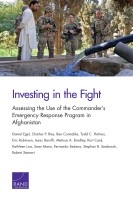| 来源类型 | Research Reports
|
| 规范类型 | 报告
|
| DOI | https://doi.org/10.7249/RR1508
|
| ISBN | 9780833096692
|
| 来源ID | RR-1508-OSD
|
| Investing in the Fight: Assessing the Use of the Commander's Emergency Response Program in Afghanistan |
| Daniel Egel; Charles P. Ries; Ben Connable; Todd C. Helmus; Eric Robinson; Isaac Baruffi; Melissa A. Bradley; Kurt Card; Kathleen Loa; Sean Mann; et al.
|
| 发表日期 | 2016
|
| 出版年 | 2016
|
| 页码 | 320
|
| 语种 | 英语
|
| 结论 |
CERP Spending Can Be Effective When Nested Within Operations- CERP operations are associated with enhancing the security and economic environment of the local population over the long term and long-term reductions in violent attacks against coalition forces.
Analysis Suggests That Quantitative Measures of CERP Spending Function as a Proxy for Overall Coalition Activity- CERP spending on compensation payments, local security, and humanitarian assistance seem to function as a proxy for coalition-kinetic military operations, while spending on agriculture, public services, transportation, and water functions as a proxy for development-focused military operations.
CERP Implementers Employed a Diversity of "Theories of Change" in Their Application of CERP- The implementers' theories of change are the causal pathways through which they believe they could achieve these population- and coalition-focused outcomes.
"Softer" Outcomes (e.g., Building Relationships with Locals) Were More Important to Implementers Than Building Infrastructure- Projects were much more effective in building rapport, freedom of movement for locals and coalition forces, and local governance and security.
- Efforts to improve these softer outcomes were reportedly successful some 75–80 percent of the time.
Almost All Operators Indicated That Implementation in Afghanistan Was Far from Optimal and That Significant Changes to the Program Should Be Made- Significant challenges face the program, either in terms of the way that it was administered by the U.S. Department of Defense (DoD) or implemented in the field.
- The challenges highlighted by these operators echoed the perspectives offered by senior leaders and the existing literature on CERP.
|
| 摘要 |
- Consider restricting CERP to only small dollar-value projects. Many of the operators we interviewed indicated that CERP was one of the few DoD programs where it was truly possible to do "more for less," as small projects were easier to implement, monitor, and control and were thus typically perceived as being more effective than larger projects.
- Develop processes that ensure that CERP projects are effectively transitioned to incoming units. The transition of incomplete projects from one unit to the next often created significant problems for the incoming units.
- Ensure that all relevant units have personnel with appropriate training and experience to execute CERP. While the Special Operation Forces (SOF) community was able to rely on the expertise of civil-affairs teams in executing CERP in Afghanistan, these teams were often few and far between, even for the Special Operation Forces community.
- Create a more formal role for United States Agency for International Development (USAID) and civilian authorities in the implementation of CERP. Both military and civilian personnel highlighted the value of USAID involvement in the implementation of CERP.
|
| 主题 | Afghanistan
; Civil-Military Relations
; Counterinsurgency
; Peacekeeping and Stability Operations
; Special Operations Forces
|
| URL | https://www.rand.org/pubs/research_reports/RR1508.html
|
| 来源智库 | RAND Corporation (United States)
|
| 引用统计 |
|
| 资源类型 | 智库出版物
|
| 条目标识符 | http://119.78.100.153/handle/2XGU8XDN/108259
|
推荐引用方式
GB/T 7714 |
Daniel Egel,Charles P. Ries,Ben Connable,et al. Investing in the Fight: Assessing the Use of the Commander's Emergency Response Program in Afghanistan. 2016.
|
|
文件名:
|
x1495316239045.jpg
|
|
格式:
|
JPEG
|

|
文件名:
|
RAND_RR1508.pdf
|
|
格式:
|
Adobe PDF
|
除非特别说明,本系统中所有内容都受版权保护,并保留所有权利。